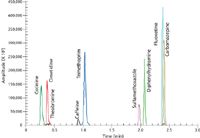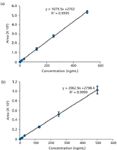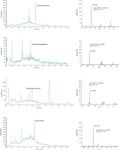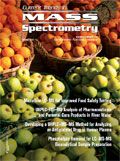Analysis of Pharmaceuticals and Personal Care Products in River Water Samples by UHPLC–TOF-MS
Special Issues
A study of pharmaceuticals and personal care products in river water samples is presented from northeastern United States using ultrahigh-pressure liquid chromatography (UHPLC) coupled with TOF-MS for both targeted and nontargeted analytes
In this study, ultrahigh-pressure liquid chromatography–time-of-flight mass spectrometry (UHPLC–TOF-MS) was used to analyze nine targeted pharmaceuticals and personal care products and several unknown compounds in North American river water samples.
Several pharmaceuticals and personal care products (PPCPs) have been detected in surface river waters, raising concerns about water pollution (1). Many of these PPCPs are released into rivers and streams anthropogenically from municipal sewage treatment plants. There is inefficient breakdown of the chemically synthesized PPCPs in the sewage treatment plants and the resulting effluent released from these plants carries the products into rivers. There is a growing concern for detecting PPCPs in aquatic systems because of the potential risk they pose to aquatic and human life. Reliable analytical techniques to identify and quantify PPCPs are important to develop. The diversity in the chemical nature of PPCPs, along with low concentrations of these analytes in complex matrices, makes these methods challenging to develop.
PPCPs have been quantified using gas chromatography–mass spectrometry (GC–MS) methods, which require derivatization to make the analytes more volatile (2). Besides GC–MS, liquid chromatography (LC)–triple-quadrupole MS methods have been developed, which do not require derivatization and are less tedious (3). However, triple-quadrupole mass spectrometers are often set to acquire in multiple reaction monitoring (MRM) mode, which does not allow for the simultaneous acquisition of full spectral information. Besides, quadrupole MS systems exhibit very poor sensitivity in scan mode, which limits their use to identify unknown analytes such as the wide variety of PPCPs. Unlike quadrupole instruments, time-of-flight (TOF) mass spectrometers show high sensitivity while acquiring full spectrum information, making them ideal for analyzing and identifying an unlimited number of compounds without prior knowledge of target analytes or when reference standards are not available. The parts-per-million mass accuracy provided by TOF mass spectrometers helps to determine elemental composition, thereby aiding identification of unknowns. The TOF systems fitted with newer analog-to-digital conversion technologies offer a wide dynamic range equivalent to triple-quadrupole systems. Similar to quadrupole instruments, TOF mass spectrometers can be used for quantifying known targets yet have the added advantage of identifying unknown compounds.
Here, we present a study of PPCPs in river water samples from northeastern United States using ultrahigh-pressure liquid chromatography (UHPLC) coupled with TOF-MS for both targeted and nontargeted analytes. In this study, we show how high mass accuracy information along with compound identification software can be used to identify unknown analytes in surface river waters.
Experimental Conditions
Sample Collection and Preparation
River samples (400 mL) were collected in 1-L amber bottles about 1 mile downstream of a sewage treatment plant. Samples were filtered through Whatman glass fiber filters (GF/C, 1.2 μm) and stored at 4 °C until analysis. Before analysis, the samples were extracted through C18 solid-phase extraction (SPE) cartridges.
SPE
Phenomenex Strata-X SPE cartridges (500 mg/6 mL) were used for extraction. The cartridges were initially conditioned with methanol (5 mL) followed by water (5 mL). The filtered river sample was loaded on the cartridges with or without a spike of standard PPCPs (100 ng each) and extracted through the cartridge at 5–6 mL/min. The cartridge was dried under vacuum for ~20 min before analytes were eluted with methanol (4 mL) and acidified methanol (containing 2% formic acid, 4 mL). The eluate was dried under nitrogen to ~0.3 mL and diluted to 0.5 mL with water.
LC Conditions
A PerkinElmer Flexar FX-10 pump was used for LC analysis. Mobile-phase A was water containing 0.1% formic acid, and mobile-phase B was acetonitrile containing 0.1% formic acid. The gradient used was 10–90% B in 5 min. An injection volume of 3 μL was used in partial fill mode. A 50 mm × 2 mm, 2.7-μm dp, PerkinElmer Brownlee SPP C18 column was used for the separation.

Figure 1: The separation of PPCPs in under 2.5 min.
MS Conditions
A PerkinElmer AxION 2 TOF MS system was used with an Ultraspray 2 dual electrospray ionization source. Other conditions were as follows: ionization mode: positive; pulse mode: 100–800 m/z; capillary exit voltage: 100 V; TrapPulse mode: 100–800 m/z (D7:42, D8:63).

Table I: Instrument detection limits of PPCPs
Internal calibration was done using two ions, m/z 118.08625 and 622.02896, as lock mass ions.

Figure 2: The calibration curves for (a) sulfamethoxazole and (b) diphenylhydramine.
AxION EC ID software (PerkinElmer) was used for compound identification.

Table II: Theoretical mass, observed mass, and mass error of PPCPs
Results
In this study, a TOF-MS system was used to analyze nine targeted PPCPs and several unknown compounds present in the river water samples. The separation of the nine target analytes was achieved in less than 3 min on column (Figure 1). The low concentration of the analytes in surface waters made it necessary to preconcentrate using SPE cartridges. The SPE extraction procedure applied for a wide range of analytes resulted in an estimated 75% or greater recovery of the majority of the analytes (based on 100 ppb standard spiked in MilliQ water [Millipore]) except for the very hydrophilic analyte, cotinine, which resulted in only 20% recovery (data not shown). The operation of the TOF-MS system was in TrapPulse mode, which increases duty cycle and results in improved sensitivity (a signal increase of up to 10-fold can be observed). The instrument detection limits (Table I) for the majority of the PPCPs was less than 1 ppb except for caffeine and theobromine (4 and 8 ppb, respectively). The linearity of the PPCPs tested over 0.5–500 ppb showed excellent r2 values (Figures 2a and 2b).

Figure 3: Identification of carbamazepine, diphenylhydramine, sulfamethoxazole, and fluoxetine in river water using accurate mass and retention time matching with standards.
Analysis of Target Analytes in River Water Samples
The exact mass capabilities of TOF mass spectrometers along with reproducibility in LC retention time can be used in combination to identify the presence or absence of target analytes in samples. Table II shows the <2 ppm mass accuracy for all the PPCPs. The surface river water samples were collected about 1 mile downstream from a sewage treatment plant and were processed and analyzed as described in the methods section. The analysis revealed the presence of carbamazepine, diphenylhydramine, sulfamethoxazole, and fluoxetine in the river water samples (Figure 3). The presence of these compounds was confirmed by accurate mass and retention time matching with standards. The concentration of these analytes in river water was estimated at 0.5–2 ppb.

Figure 4: A major unknown target analyte eluted at ~2.7 min.
Analysis of Nontarget Analytes in River Water Samples
The river sample data were further examined for unknown nontarget analytes. A major chromatographic peak eluted at ~2.7 min (Figure 4) was analyzed using the compound identification software. Accurate monoisotopic mass and isotope ratio information is used by the software to search the PubChem database for potential molecular formula matches. It provides a ranked summary of the potential matches as well as suggestions for possible compound structures for a given elemental composition. In this example, the elemental composition C12H17NO was listed with highest score and the top candidate was identified as N,N-diethyl-m-toluamide (DEET) based on the number of active assay identifications reported. DEET is a common ingredient in insect repellent and the accurate mass of the unknown compound was verified to be within 2 ppm mass error of the expected mass of DEET (Figure 5). The presence of DEET in the river sample was further confirmed by retention time matching with the standard. Using a similar approach, acetaminophen, a commonly used analgesic drug, was also identified in the river water (data not shown).

Figure 5: The presence of DEET was confirmed by accurate mass data.
Conclusions
PPCPs in the environment include a diverse variety of chemicals including prescription drugs, over-the-counter drugs, chemicals used in agribusiness such as veterinary drugs, cosmetics, and fragrances. It is becoming increasingly important to understand the fate and occurrence of these chemicals in the environment since many of the chemicals are considered to cause ecological harm to animals, including possible endocrine disruption (4). Using the accurate mass capabilities of the TOF mass spectrometer, we have shown the high specificity in analysis of many of the target analytes in river water including antidepressants, antihistamines, antiseizure compounds, and antibiotics. Because of the diversity of chemicals found in the environment, there is an increasing trend to re-examine already acquired data for unknown, unexpected, or nontargeted analytes. This study shows examples of nontarget compounds that can be identified in river samples using the accurate mass and isotope ratio provided by the TOF mass spectrometer along with powerful database search tools such as the compound identification software.
References
(1) C.G. Daughton and T.A. Ternes, Environ. Health Perspect. 107, 907–938 (1999).
(2) S.A. Snyder, P. Westerhoff, Y. Yoon and D.L. Sedlak, Environ. Eng. Sci. 20, 449–469 (2003).
(3) D.W. Kolpin, E.T. Furlong, M.T. Meyer, E.M. Thurman, S.D. Zaugg, L.B. Barber, and H.T. Buston, Environ. Sci. Technol. 36, 1202–1211 (2002).
(4) F. Ingerslev, E. Vaclavik, and B. Halling-Sørensen, Pure Appl. Chem. 75, 1881–1893 (2003).
Sharanya Reddy, Sergey V. Rakov, and Blas Cerda are with PerkinElmer, Inc., in Shelton, Connecticut. Direct correspondence to: Sharanya.Reddy@perkinelmer.com.

Study Explores Thin-Film Extraction of Biogenic Amines via HPLC-MS/MS
March 27th 2025Scientists from Tabriz University and the University of Tabriz explored cellulose acetate-UiO-66-COOH as an affordable coating sorbent for thin film extraction of biogenic amines from cheese and alcohol-free beverages using HPLC-MS/MS.
Quantifying Microplastics in Meconium Samples Using Pyrolysis–GC-MS
March 26th 2025Using pyrolysis-gas chromatography and mass spectrometry, scientists from Fudan University and the Putuo District Center for Disease Control and Prevention detected and quantified microplastics in newborn stool samples.










